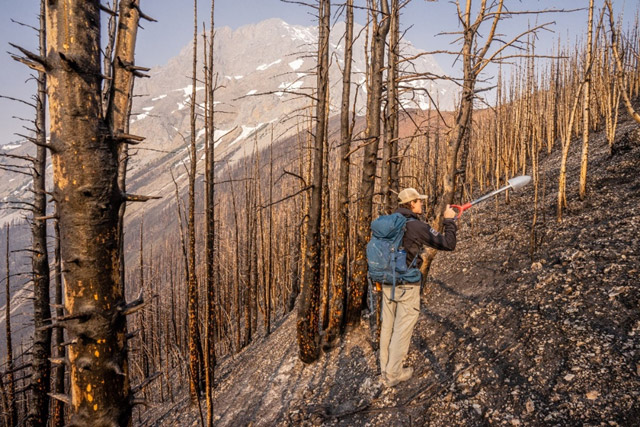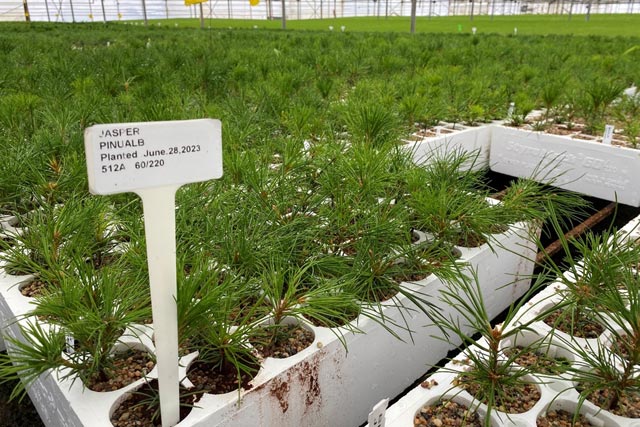
Seedlings planted on the burnt slopes of Greenock from the Chetamon wildfire.
Planting hope: Restoring whitebark pines in Jasper National Park
Jasper National Park
Most requested
In July 2024, Jasper National Park’s forests faced powerful wildfires that left behind blackened trees and bare soil. But even in the ashes, there is hope for nature to heal. Renewal takes time and may make the landscape look different, but small aspen shoots and grasses show it has already begun. However, some species and habitats need extra help, like the whitebark pine. This rare, at-risk tree is not only important for the park’s biodiversity but also a symbol of renewal.
A keystone species in trouble
Whitebark pines grow on the high, windy ridges of the subalpine. They are a species at risk and are key to their ecosystem. Their seeds are packed with nutrients, feeding wildlife like grizzlies, squirrels and Clark’s nutcrackers. The nutcracker, a bird with a sharp beak, plays a special role by collecting and storing the seeds across the mountains. Forgotten seeds often grow into new trees.
Even though whitebark pines are important, they are disappearing fast in Canada’s mountain parks. They face threats like white pine blister rust, mountain pine beetles, fire suppression and climate change. Recognizing their value, conservation efforts are now a top priority.
Ironically, wildfire, a force that has shaped these landscapes for centuries, has created new opportunities. The 2024 fires left behind open, nutrient-rich soil, perfect for whitebark pine seedlings to grow.
Turning destruction into opportunity
The wildfires this summer caused a lot of damage, but they created many chances for planting,
 Assessing planting site suitability on slope of Gargoyle burnt in the Chetamon wildfire.
Assessing planting site suitability on slope of Gargoyle burnt in the Chetamon wildfire.
Burned areas near Signal and Hardisty Mountains are especially promising. With fewer plants competing, the seedlings planted now have a better chance to grow.
Whitebark pine is known as a ‘foundation species’. It thrives in the toughest conditions, like rocky slopes, and helps other plants and animals survive by providing shelter and food.
The park’s restoration team has big goals: plant 20,000 whitebark pine seedlings every year, aiming for 150,000 by 2031. Much of this work is based on lessons learned from earlier restoration efforts after the 2022 Chetamon wildfire and the 2003 Moab Fire.
From seed to seedling
Restoring whitebark pine starts years before planting. Workers climb the trees to collect cones from those that have survived blister rust. These cones hold the seeds needed for restoration. Collecting seeds is slow, careful work.
We break apart cones by hand, pulling seeds from the sticky sap and cone scales one at a time,
After cleaning, the seeds go to nurseries where they are grown into young trees resistant to blister rust. After several years, the seedlings are ready to be planted back in Jasper’s wild landscapes.
 Cone collection.
Cone collection.
 Seed extraction.
Seed extraction.
 Seedlings grown in a nursery before returning to the park to be planted.
Seedlings grown in a nursery before returning to the park to be planted.
Planting in the wild
Planting whitebark pine seedlings in remote areas of the park is not easy. Helicopters often deliver thousands of seedlings to hard-to-reach spots. In closer locations, teams use vehicles and good old-fashioned hiking to bring in the young trees.
Teams pick planting spots carefully. They look for sunlight, good soil and the right elevation. Burned stumps and logs help protect the seedlings, while open slopes give them space to grow. The planting process copies how trees grow naturally. Seedlings are planted alone or in small groups, which helps them hold moisture and stay safe from wind and sun.
Burned areas are like a blank canvas for whitebark pine restoration. With little other vegetation, the seedlings can grow quickly in the nutrient-rich soil.
 Heli slinging seedlings in to McLarens Pass.
Heli slinging seedlings in to McLarens Pass.
 Planting seedlings by hand.
Planting seedlings by hand.
Restoring an ecosystem
Restoring whitebark pine does more than save a single species, it helps the entire ecosystem. These trees slow snowmelt, which can prevent spring floods and their shade helps other plants and animals thrive.
The partnership between whitebark pine and Clark’s nutcracker is a great example of how species depend on each other. Fires like those in 2024 create more places for the nutcracker to store seeds, helping the whitebark pine spread across the landscape. By restoring whitebark pine, we are protecting this special relationship and ensuring the species survives for years to come.
Seeds of hope
As Jasper’s landscape begins to heal, whitebark pine restoration brings hope for the future. In the fall of 2025, thousands of seedlings will be planted on the slopes of Signal Mountain, Roche Bonhomme, and other newly cleared areas.
These trees are a symbol of resilience. By planting them now, we’re not just restoring what was lost, we’re building a stronger, more diverse ecosystem for future generations.
Visitors exploring Jasper’s trails may see small whitebark pine seedlings growing in the ashes. Each one is a reminder of nature’s amazing ability to heal and the vital role Parks Canada plays in protecting and conserving these wild spaces.
- Date modified :